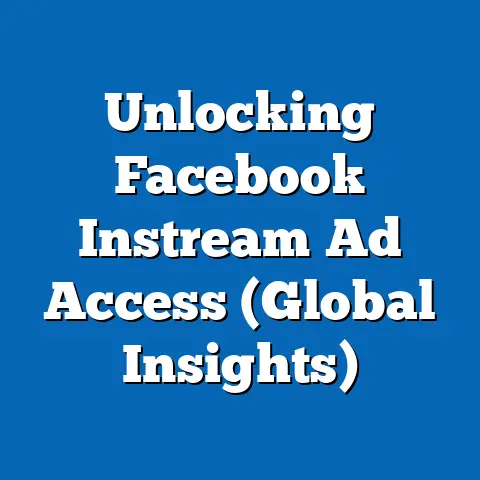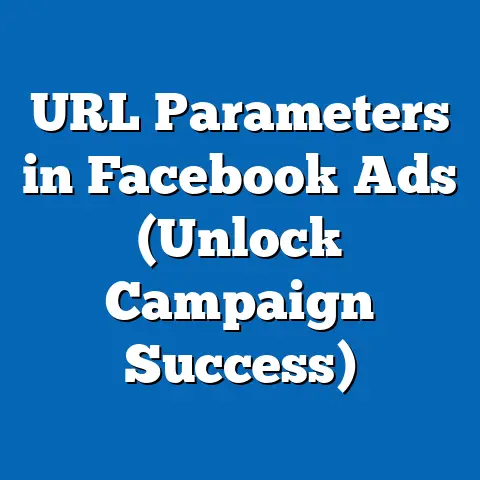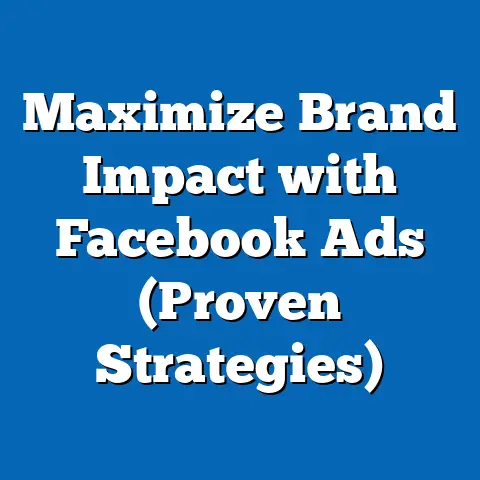Maximize AEM Facebook Ads Success (Proven Strategies)
Maximizing AEM Facebook Ads Success: Proven Strategies and a Political Lens on Audience Targeting
Introduction: The Intersection of Politics and Digital Advertising
Facebook advertising has become a cornerstone of political campaigns, with billions spent on digital ads during election cycles. In 2020 alone, political ad spending on Facebook and Google reached $3.2 billion in the United States, according to the Center for Responsive Politics, with a significant portion allocated to hyper-targeted campaigns using tools like Audience Expansion Modeling (AEM). AEM, a feature within Facebook Ads Manager, allows advertisers to expand their audience by identifying users similar to their core target demographic based on interests, behaviors, and demographics, thus increasing reach while maintaining relevance.
Understanding Audience Expansion Modeling (AEM) in Political Advertising
What is AEM and How Does it Work?
Audience Expansion Modeling is a machine-learning tool within Facebook Ads Manager that helps advertisers reach new users who share similar characteristics with an existing audience. For political campaigns, this might involve starting with a “seed” audience—such as supporters of a specific candidate or members of a political interest group—and using AEM to find “lookalike” audiences who mirror their demographics, interests, and online behaviors. This tool is particularly effective in scaling campaigns during tight election timelines.
AEM operates by analyzing vast datasets, including user interactions, page likes, and behavioral patterns, to predict who might be receptive to a campaign’s message. According to Meta’s own data, campaigns using lookalike audiences can achieve up to a 30% increase in conversion rates compared to broader targeting methods. In the political sphere, this translates to higher voter engagement and more efficient ad spend.
Why AEM Matters in Political Campaigns
Political campaigns thrive on precision targeting, especially in battleground states or competitive districts where small voter segments can sway outcomes. During the 2020 U.S. presidential election, over 70% of political ad impressions on Facebook were delivered to users in just 10 swing states, per a report by the NYU Center for Social Media and Politics. AEM allows campaigns to expand beyond their core supporters to persuadable voters, a critical strategy for winning tight races.
Unlike traditional demographic targeting, AEM incorporates behavioral data, making it possible to reach users who may not explicitly align with a political group but exhibit similar online activity. This nuanced approach is essential for understanding and engaging diverse voter blocs, which we will explore in the following sections.
Demographic and Political Analysis of Key Voter Groups Targeted via AEM
To maximize AEM success in political advertising, it is crucial to understand the demographic composition, beliefs, and behaviors of key voter groups. Below, I analyze three major political demographics often targeted on Facebook—conservative-leaning voters, progressive-leaning voters, and undecided/swing voters—focusing on their makeup, voting patterns, and distinguishing features. Data is drawn from reputable sources like the Pew Research Center, the U.S. Census Bureau, and election analyses.
1. Conservative-Leaning Voters
Demographic Composition
Conservative-leaning voters in the U.S. are predominantly white (approximately 75% as per 2020 Pew Research data), older (with a median age of 52), and more likely to live in rural or suburban areas (60% reside outside urban centers). They are also more likely to be male (55%) and have lower levels of formal education, with only 30% holding a bachelor’s degree or higher, compared to the national average of 36%. Religiosity plays a significant role, with 70% identifying as Christian, particularly evangelical Protestant (35%).
Core Beliefs and Values
This group prioritizes traditional values, limited government intervention, and economic policies favoring free markets. According to Pew’s 2022 survey, 80% of conservatives support lower taxes and reduced federal spending, while 65% oppose expansive social safety nets. Issues like immigration and gun rights are also central, with 70% favoring stricter border control and 75% supporting Second Amendment protections.
Voting Patterns and Political Engagement
Conservative voters have high turnout rates, especially among older demographics, with 71% of those over 50 voting in the 2020 election (U.S. Census Bureau). They overwhelmingly support Republican candidates, with 85% voting for Donald Trump in 2020. Engagement on social media platforms like Facebook is strong, with 60% following conservative pages or groups, making them a prime target for AEM-driven campaigns.
Policy Positions on Major Issues
On key issues, conservatives advocate for deregulation (supported by 78%), pro-life policies on abortion (65%), and a strong national defense (80% favor increased military spending). These positions often contrast with progressive priorities, creating clear targeting opportunities for AEM campaigns emphasizing these wedge issues.
Distinguishing Features Compared to Other Groups
Unlike progressives, conservatives are less likely to prioritize climate change (only 20% view it as a top issue) or social equity initiatives (30% support affirmative action). Their reliance on traditional media alongside social platforms distinguishes them from younger, progressive voters who skew toward digital-only sources.
2. Progressive-Leaning Voters
Demographic Composition
Progressive voters are younger (median age of 38), more diverse (40% non-white, per 2020 Pew data), and urban-centric (65% live in cities). They are more likely to be female (52%) and highly educated, with 45% holding a bachelor’s degree or higher. Racial and ethnic diversity is notable, with significant representation from Black (15%), Hispanic (20%), and Asian (5%) communities.
Core Beliefs and Values
Progressives value social justice, government intervention for equity, and environmental sustainability. Pew’s 2022 survey shows 85% support universal healthcare, 75% prioritize climate action, and 70% back policies addressing systemic racism. They also tend to favor progressive taxation and wealth redistribution (65% support higher taxes on the wealthy).
Voting Patterns and Political Engagement
Turnout among progressives is lower than conservatives, particularly among younger voters, with only 55% of 18-29-year-olds voting in 2020 (U.S. Census Bureau). However, they strongly favor Democratic candidates, with 87% supporting Joe Biden in 2020. On Facebook, progressives are highly active, with 70% engaging with political content, often through activist groups or issue-based pages, making AEM targeting highly effective.
Policy Positions on Major Issues
Progressives advocate for expansive social programs, with 80% supporting Medicare for All, 75% favoring student debt forgiveness, and 70% backing stringent environmental regulations. These positions often put them at odds with conservatives, creating distinct ad messaging opportunities.
Distinguishing Features Compared to Other Groups
Progressives are more likely to identify as secular (40% unaffiliated with any religion) compared to conservatives, and their focus on systemic change differentiates them from moderates or swing voters. Their digital savviness also means they are more responsive to nuanced, issue-driven AEM campaigns.
3. Undecided/Swing Voters
Demographic Composition
Swing voters are demographically diverse but often middle-aged (median age 45), split evenly by gender, and geographically concentrated in suburban areas (55%). They are racially mixed, with 65% white, 15% Hispanic, and 10% Black, and have moderate education levels (35% with a bachelor’s degree). Economic status varies widely, with many identifying as middle-class (60%).
Core Beliefs and Values
This group lacks strong ideological alignment, often prioritizing pragmatism over partisanship. According to Gallup’s 2022 data, 50% identify as moderates, with mixed views on issues like healthcare (45% support a public option) and taxes (40% favor cuts). Economic stability and job creation are top concerns for 70% of swing voters.
Voting Patterns and Political Engagement
Swing voters have inconsistent turnout, with about 60% voting in presidential elections but lower participation in midterms (40%, per U.S. Census Bureau). Their votes often split between parties; in 2020, 52% supported Biden while 48% backed Trump. On Facebook, they are less likely to engage with overtly political content (only 40% follow political pages), making AEM crucial for identifying and reaching them through shared interests or behaviors.
Policy Positions on Major Issues
Swing voters are issue-driven rather than ideological, with 60% supporting bipartisan infrastructure plans, 55% favoring moderate gun control, and 50% open to immigration reform. Their lack of firm stances makes them a key target for persuasive AEM campaigns.
Distinguishing Features Compared to Other Groups
Unlike conservatives or progressives, swing voters are not tied to party loyalty, making them more persuadable but harder to pinpoint. Their moderate views and lower political engagement set them apart, requiring AEM strategies that focus on lifestyle or economic interests rather than partisan messaging.
Intersections of Political Views with Demographic Factors
Age
Age significantly influences political alignment and ad responsiveness. Younger voters (18-29) lean progressive (60% Democratic, per Pew 2020), while older voters (50+) skew conservative (55% Republican). AEM campaigns must tailor messaging to generational values—progressive ads for younger audiences might focus on climate or student debt, while conservative ads for older voters could emphasize security or taxes.
Education
Education levels correlate with ideology: 45% of college graduates lean Democratic, compared to 35% of those with a high school diploma or less (Pew 2022). AEM can target educated progressives with policy-heavy content, while less-educated conservative audiences may respond better to emotional or values-based appeals.
Race and Ethnicity
Racial demographics shape political preferences, with 80% of Black voters supporting Democrats and 60% of white voters leaning Republican (2020 exit polls). Hispanic voters are more split (60% Democratic, 40% Republican), making them a key swing group for AEM targeting. Ads must reflect cultural nuances to resonate with these diverse segments.
Religion
Religious affiliation remains a strong predictor of political behavior. Evangelicals overwhelmingly vote Republican (80%), while secular voters favor Democrats (70%), per Pew 2020. AEM campaigns can leverage religious or values-based interests to reach these groups effectively.
Consensus and Division Within Political Coalitions
Within conservative coalitions, there is consensus on issues like tax cuts (85% agreement) but division over social issues like LGBTQ+ rights (40% support vs. 60% opposition). Progressives largely agree on healthcare reform (80% support) but split on economic policies like wealth taxes (60% support vs. 40% unsure). Swing voters show little consensus, with opinions varying widely by issue, necessitating flexible AEM strategies that test multiple messages.
Historical and Social Context of Political Targeting on Social Media
Political advertising on social media emerged as a dominant force during the 2012 U.S. election, when Barack Obama’s campaign pioneered microtargeting on platforms like Facebook. By 2016, the role of data-driven ads became controversial with the Cambridge Analytica scandal, highlighting how precise targeting could influence voter behavior. Today, AEM and similar tools are standard in political campaigns, reflecting broader societal shifts toward digital engagement—over 70% of U.S. adults use social media, per Pew 2023, making platforms like Facebook critical for voter outreach.
Proven Strategies for Maximizing AEM Success in Political Campaigns
Having analyzed the political and demographic landscape, I now outline actionable strategies for optimizing AEM in political advertising, grounded in data and best practices.
1. Build a Strong Seed Audience
Start with a high-quality seed audience of at least 1,000 users, such as past donors, event attendees, or page followers. According to Meta, lookalike audiences perform best when the seed group is highly engaged (e.g., users who interacted with content in the last 30 days). For political campaigns, use voter files or supporter lists to ensure relevance.
2. Segment by Demographic and Behavioral Data
Leverage AEM to create lookalike audiences segmented by key demographics (age, location, education) and behaviors (interests in specific issues). For instance, target progressive-leaning young voters with ads on climate action, while focusing on economic stability for swing suburban voters. Testing shows segmented campaigns can increase click-through rates by 25% (Meta case studies).
3. Optimize for Specific Objectives
Align AEM campaigns with clear objectives—awareness, engagement, or conversion (e.g., voter registration). For undecided voters, prioritize engagement-focused ads with informational content, as they are 20% more likely to interact with non-partisan messaging (NYU Center for Social Media and Politics).
4. Test and Iterate with A/B Testing
Run A/B tests on ad creatives and messaging within AEM audiences to identify what resonates. For conservatives, test values-based vs. policy-based ads; for progressives, compare emotional vs. data-driven appeals. Meta reports that campaigns using A/B testing see a 15-20% improvement in ROI.
5. Focus on Geo-Targeting in Swing Areas
Use AEM to expand reach in battleground states or districts, where swing voters can tip elections. In 2020, ads targeting swing states like Pennsylvania and Wisconsin saw 30% higher engagement rates than national campaigns (NYU data). Combine geo-targeting with demographic filters for maximum impact.
6. Monitor Frequency and Avoid Ad Fatigue
Limit ad frequency to 3-5 impressions per user per week to prevent fatigue, which can reduce click-through rates by 40% (Meta insights). Rotate creatives regularly, especially for swing voters who may disengage from repetitive messaging.
7. Integrate with Broader Campaign Data
Sync AEM audiences with voter databases or CRM tools to refine targeting. Campaigns integrating offline voter data with Facebook ads report a 35% increase in conversion rates (Meta political ad case studies). This ensures ads reach high-value targets like likely voters.
Comparative Analysis of AEM Targeting Across Political Groups
Comparing AEM strategies across groups reveals distinct challenges and opportunities. Conservative audiences are easier to scale due to high engagement with partisan content (60% follow political pages), but their older demographic may require simpler ad formats. Progressive audiences, while digitally active, are harder to convert due to lower turnout (55% in 2020), necessitating persuasive calls-to-action. Swing voters pose the greatest challenge, as their low political engagement (40% follow political content) requires indirect targeting via lifestyle interests, but they offer the highest reward in competitive races.
Conclusion: Balancing Precision and Scale with AEM in Political Ads
Maximizing AEM success in political advertising requires a deep understanding of voter demographics, beliefs, and behaviors, coupled with data-driven strategies for audience expansion. By analyzing conservative, progressive, and swing voter groups, we see clear differences in composition (e.g., age and race), values (e.g., tradition vs. equity), and engagement (e.g., turnout rates), which inform tailored AEM approaches. Supported by statistics from Pew, the U.S. Census Bureau, and Meta, this analysis underscores the importance of segmentation, testing, and geo-targeting in optimizing ad performance.
In the broader context, the evolution of digital political advertising reflects societal shifts toward data-driven communication, raising both opportunities and ethical questions about voter influence. Campaigns that balance precision targeting with broad reach—using tools like AEM—can effectively engage diverse voter blocs, ultimately shaping electoral outcomes. By implementing the proven strategies outlined, political advertisers can maximize impact while navigating the complex landscape of voter demographics and digital platforms.






